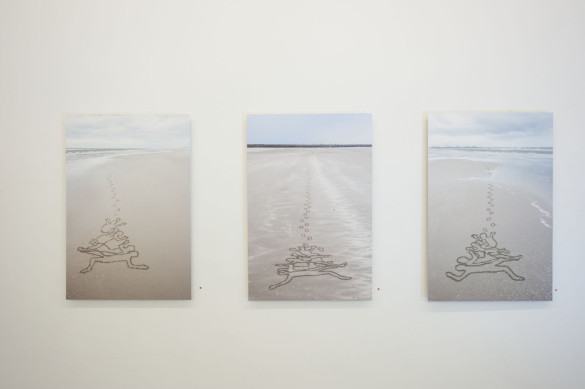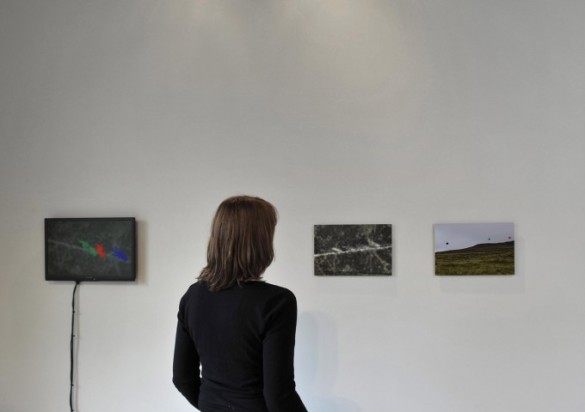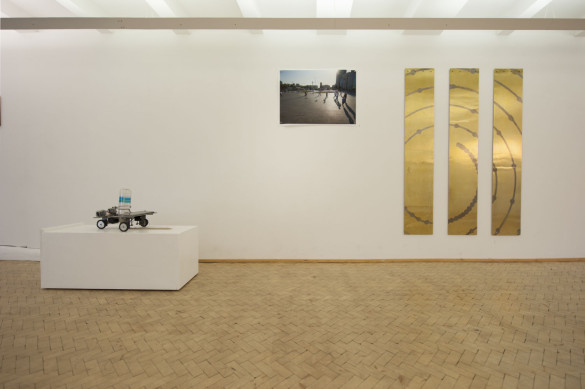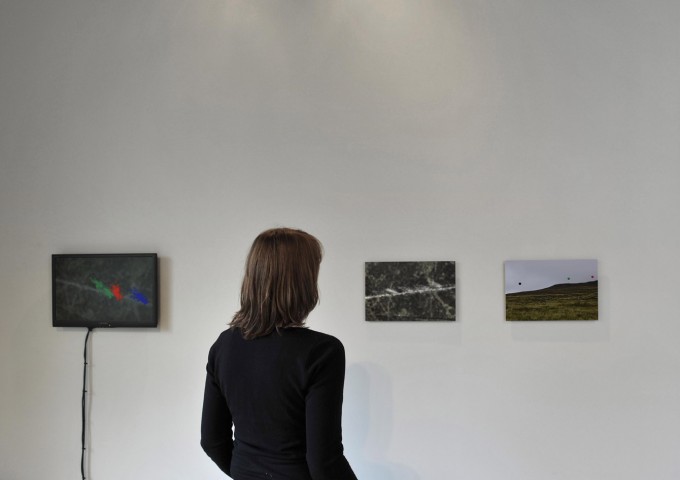Last week I visited the exhibition Move Still Move at Rento Brattinga Galerie in Amsterdam, an intriguing exploration of gps technology as an artistic medium by the artist duo PolakvanBekkum.
Esther Polak is one of the most interesting (and first) artists working within the medium of GPS (and a contributor to our first The Mobile City conference in 2008). She gained international acclaim with the project Amsterdam Real Time (a cooperation with Jeroen Kee), one of the first projects to use GPS to record the movement of citizens through a city. In 2005 she won the Golden Nica at Ars Electronica with Milk (in collaboration with Ieva Auzina). Again, working with GPS-recordings, the artists visualized the movements of the international food trade, by following a batch of milk produced by Latvian Farmers to a Dutch Cheese wharehouse, and on to the breakfast tables at which the cheese was consumed. A few years later she engaged on a similar adventure in Nigeria, with Nomadic Milk. There she traced the routes of the Fulani, a cow herding nomad tribe.

All these projects were mostly documentary in nature, using new technologies to explore the intricate geographies of globalized living, that link up ancient nomad routes with modernized industrial food production. At the same time, these projects had a social aspect as well. The mappings were visualized in attractive and innovative ways, for instance by a little robot cart hat drew out the Fulani-routes by dispersing a sand trail on the surface of both Nigerian concrete sidewalks as well as international gallery floors. One of the most interesting moments in the production of these art works was the confrontation of the ‘authors’ of these maps, and the visualization of their accumulated gps-data: a portret of their daily routines as they had never seen it before, opening up new ways of imaging ourselves and our social relations.
Over the last few years Polak has teamed up with Ivar van Bekkum, and their work has departed from this documentary frame towards a more direct engagement with the history of art. The artists see a parallel here with the development of photography. Just like GPS, it started off as a documentary medium, but later on developed as a more artistic mode of expression. One that not so much acted as a window on a time and spacewise distant world, but rather one that started to interpret that world, from abstract to poetic representations, and from critical as well as celebratory points of view.

In the exhibition Move Still Move this turn in their work becomes immediately apparent. For instance the work Wall Drawing Wind explores the poetic affordances of gps-recording, as well as its formal relationship with other means of documenting reality. The work visualizes the movement of three helium filled balloons through the Scottish Highlands in three ways: a regular photograph of the three balloons in the decor of rugged Scottish emptiness; A satellite photo with the cumulative recorded trails of the balloons inscribed into it; as well as an animation showing the movement trough time.
Many works do still trace the movement of people or things (fishing boats, the sun, the artists themselves when they happen by pure chance to be photographed by the Google Street View Car), but the goal is not so much to document these processes, as well as to investigate various ways of expressing these movements within this medium.
They have also started an interesting dialogue with the tradition of Landart, in which giant patterns are inscribed into the landscape, usually using elements of that landscape itself. Somewhat similarly, PolakvanBekkum use the landscape to make our current day data society visible within our physical environment. Nowadays numerous technologies record our existence in various databases, but normally these traces remain invisible to us. PolakvanBekkum bring these traces back into the real world again, to invite us to ponder over all these traces we leave behind or record. For instance in Spiral Drawing Sunrise, the movement of the sun, recorded by a small robot, is turned into a spiral pattern laid out in sand on the squares of Istanbul and Marrakech.

Some works do not even use GPS-technology itself , even though they urge the viewer to reflect on the algorithmization of our society. One of my favourite works is actually rather simple technologically. It is a video that shows an undefined European city square, one of those cobble stoned places equally populated by humans and pigeons (it is actually the square in front of Paris’ Centre Pompidou, but it could have been anywhere in Europe really).
In the film, the pigeons take over part of the square, but somehow they assemble in the coherent pattern of a semi-circle. Once a little boy enters the stage, the pigeons fly off, but immediately reappear once the boy’s rush has ended, again flocking in the same orderly pattern. This interaction repeats itself many times over.
π boy from PolakVanBekkum on Vimeo.
The secret here is that there’s an invisible circle of pigeon feed, that attracts the pigeons in the pattern. In the context of this exhibition centered on data recording and representation it’s not hard to make an analogy with our own behavior. We might not follow the patterns of pigeon feed laid out to us by an artist duo, but we do increasingly navigate through our cities following the traces laid out for us by companies such as Google or TomTom. These are equally invisible in the real world as the pigeon feed is to us in the video, but again likewise, they do lead us to form spatial patterns in new ways.
The exhibition is on view until February 15th 2014 in Rento Brattinga galerie, Lauriergracht 80 in Amsterdam, The Netherlands. There is a special finnisage event on February 15th at 16:00 hours with a lecture by Karen O’Rourke and a response by Arjen Mulder, see the official invite below.
Finissage
February 15
4 pm until 5.30 pm
RSVP info@rentobrattinga.com
Art as cartography or cartography as art?
A lively afternoon with improvised lecture/mini guided tour/discussion
Being a specialist in the field of ‘art as cartography’, Karen O’Rourke will outline context for the work in the exhibition Move Still Move. Arjen Mulder will respond to this from his own point of view and both will engage in a conversation with the artists.
Karen O’Rourke is the author of the recent published book Walking and Mapping, Artists as Cartographers (for sale in the gallery), and professor at the Paris Université 1 Sorbonne.
Arjen Mulder is biologist, essayist, author of several books on media theory, teacher at the HKU in Utrecht and works for V2 in Rotterdam.
Lecture will be in English

